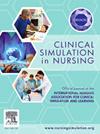双视角和触觉反馈虚拟现实模拟用于分娩护理:一项随机对照混合方法研究
IF 2.5
3区 医学
Q1 NURSING
引用次数: 0
摘要
分娩护理需要复杂的决策和疼痛管理技能,但目前的虚拟方法,如基于球形视频的虚拟现实(SVVR),缺乏触觉反馈和交互性。目的比较虚拟现实同步触觉反馈系统(VR-SHFS)与SVVR在提高护生劳动护理技能、知识和共情能力方面的效果。方法随机对照混合方法研究,选取VR-SHFS学生(n=40)或SVVR学生(n=40)。VR-SHFS采用触觉反馈和双视角学习,而SVVR采用360°全景视频。在基线(T0)、干预后立即(T1)和两个月随访(T2)评估结果。结果与SVVR相比,vr - shfs显著提高了劳动护理技能(T1: P < .001; T2: P < .001)和同理心(T1: P = .014; T2: P = .003),并增强了T2时的知识保留(P < .001)。学生们很重视它的现实性和互动性,尽管他们注意到需要指导和熟悉。结论带有触觉反馈和双视角的svr比SVVR更有效地提高了分娩护理培训的效果,具有广阔的临床应用前景。本文章由计算机程序翻译,如有差异,请以英文原文为准。
Dual-perspective and haptic feedback virtual reality simulation for labor care: A randomized controlled mixed-methods study
Background
Labor care requires complex decision-making and pain management skills, yet current virtual methods, such as spherical video-based virtual reality (SVVR), lack haptic feedback and interactivity.
Objective
To evaluate the effectiveness of a virtual reality synchronous haptic feedback system (VR-SHFS) compared with SVVR in improving nursing students’ labor care skills, knowledge, and empathy.
Methods
Randomized controlled mixed-methods study with students in VR-SHFS (n=40) or SVVR (n=40). VR-SHFS incorporated haptic feedback and dual-perspective learning, whereas SVVR employed 360° panoramic videos. Outcomes were assessed at baseline (T0), immediately after the intervention (T1), and at two-month follow-up (T2).
Results
VR-SHFS significantly improved labor care skills (T1: P < .001; T2: P < .001) and empathy (T1: P = .014; T2: P = .003), and enhanced knowledge retention at T2 (P < .001), compared with SVVR. Students valued its realism and interactivity, although they noted a need for guidance and familiarization.
Conclusions
VR with haptic feedback and dual perspectives enhances labor care training more effectively than SVVR and shows promise for broader clinical education.
求助全文
通过发布文献求助,成功后即可免费获取论文全文。
去求助
来源期刊

Clinical Simulation in Nursing
NURSING-
CiteScore
5.50
自引率
15.40%
发文量
107
期刊介绍:
Clinical Simulation in Nursing is an international, peer reviewed journal published online monthly. Clinical Simulation in Nursing is the official journal of the International Nursing Association for Clinical Simulation & Learning (INACSL) and reflects its mission to advance the science of healthcare simulation.
We will review and accept articles from other health provider disciplines, if they are determined to be of interest to our readership. The journal accepts manuscripts meeting one or more of the following criteria:
Research articles and literature reviews (e.g. systematic, scoping, umbrella, integrative, etc.) about simulation
Innovative teaching/learning strategies using simulation
Articles updating guidelines, regulations, and legislative policies that impact simulation
Leadership for simulation
Simulation operations
Clinical and academic uses of simulation.
 求助内容:
求助内容: 应助结果提醒方式:
应助结果提醒方式:


